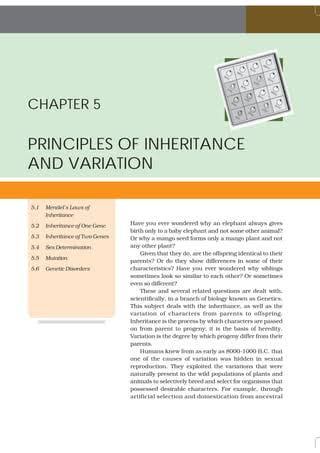Summary
Chapter 5 of Class 12 Biology, titled “Principles of Inheritance and Variation,” delves into the fundamental concepts of genetics, focusing on how traits are passed from parents to offspring. This chapter begins by exploring the history of genetics, emphasizing Gregor Mendel’s pioneering work on pea plants, which laid the foundation for understanding inheritance patterns. Mendel’s laws of inheritance, including the Law of Segregation and the Law of Independent Assortment, are central to this chapter. The chapter explains how these laws govern the distribution of alleles and determine the phenotypic expression of traits.

Class 12 Biology Chapter 5 Principles of Inheritance and Variation Book 📚 download in PDF format 👇👇
Further, the chapter discusses the concept of incomplete dominance, co-dominance, multiple alleles, and polygenic inheritance, showcasing the complexity of genetic interactions. The chromosomal theory of inheritance, which links Mendel’s principles to chromosome behavior during meiosis, is also covered in detail. The chapter also examines sex determination mechanisms, including the XX-XY system in humans, and the role of sex-linked inheritance in conditions such as hemophilia and color blindness.
Moreover, the chapter touches upon genetic disorders, distinguishing between Mendelian and chromosomal disorders, with examples like cystic fibrosis, Down syndrome, and Turner syndrome. It also briefly introduces the concept of mutations, their types, and their effects on genetic material.
Overall, this chapter provides a comprehensive understanding of how genetic variation occurs, the mechanisms behind it, and the importance of inheritance in the continuity of life. It lays a strong foundation for further studies in genetics, evolutionary biology, and biotechnology.
Short Answer Questions
What is the Law of Segregation?
The Law of Segregation states that during the formation of gametes, the alleles for each gene separate, so each gamete carries only one allele for each gene.
Define co-dominance.
Co-dominance is a form of inheritance where both alleles contribute equally and visibly to the phenotype of the organism, such as in AB blood type.
What is a monohybrid cross?
A monohybrid cross is a genetic cross between individuals that involves one pair of contrasting traits, typically focusing on one gene.
Explain the concept of incomplete dominance.
Incomplete dominance occurs when the phenotype of the heterozygote is intermediate between the phenotypes of the two homozygotes, such as pink flowers from red and white parents.
What are multiple alleles?
Multiple alleles refer to the presence of more than two alleles for a genetic trait within a population, though an individual can possess only two of these alleles.
Describe the chromosomal theory of inheritance.
The chromosomal theory of inheritance states that genes are located on chromosomes, and the behavior of chromosomes during meiosis explains the patterns of inheritance.
What is a test cross?
A test cross involves crossing an individual with a dominant phenotype but unknown genotype with a homozygous recessive individual to determine the unknown genotype.
Define polygenic inheritance.
Polygenic inheritance is the inheritance of traits controlled by two or more genes, often resulting in a continuous distribution of phenotypes, like height or skin color.
What is a dihybrid cross?
A dihybrid cross involves two traits and examines the inheritance patterns of alleles for these traits from the parental generation.
Explain the significance of the Law of Independent Assortment.
The Law of Independent Assortment states that alleles of different genes assort independently of one another during gamete formation, leading to genetic variation.
Long Answer Questions
Describe Mendel’s experiments and their significance in genetics.
Mendel conducted experiments on pea plants to study the inheritance of traits. He focused on traits such as seed color and shape, conducting monohybrid and dihybrid crosses. His observations led to the formulation of the Laws of Inheritance, namely the Law of Segregation and the Law of Independent Assortment. These laws explained how traits are passed down from parents to offspring and how genetic variation is maintained in populations. Mendel’s work laid the foundation for modern genetics, providing a scientific basis for understanding inheritance and the role of genes in determining traits.
What are sex-linked traits? Discuss with examples.
Sex-linked traits are traits associated with genes located on sex chromosomes. These traits often show different patterns of inheritance in males and females due to the presence of one X and one Y chromosome in males, and two X chromosomes in females. An example is hemophilia, a disorder where blood doesn’t clot properly, caused by a recessive gene on the X chromosome. Males, having only one X chromosome, are more likely to express the disorder if they inherit the defective gene. Another example is color blindness, which is also X-linked and more common in males.
Explain the mechanism of sex determination in humans.
In humans, sex determination is based on the XX-XY system. Females have two X chromosomes (XX), while males have one X and one Y chromosome (XY). During reproduction, the mother contributes an X chromosome, and the father contributes either an X or a Y chromosome. If the sperm carries an X chromosome, the offspring will be female (XX); if it carries a Y chromosome, the offspring will be male (XY). The presence of the SRY gene on the Y chromosome triggers the development of male characteristics, determining the sex of the offspring.
Discuss the chromosomal basis of inheritance with reference to linked genes.
Linked genes are genes located close together on the same chromosome and tend to be inherited together. The chromosomal basis of inheritance explains that chromosomes, which carry genes, segregate independently during meiosis. However, when genes are linked, they do not follow the Law of Independent Assortment as they are inherited as a group. Crossing over during meiosis can sometimes separate linked genes, leading to recombination and new allele combinations in offspring. This concept is crucial in understanding genetic linkage and mapping genes on chromosomes.
What are Mendelian disorders? Explain with examples.
Mendelian disorders are genetic disorders caused by mutations in a single gene, following Mendelian patterns of inheritance. They can be autosomal dominant, autosomal recessive, or sex-linked. Examples include cystic fibrosis, an autosomal recessive disorder causing mucus buildup in the lungs; sickle cell anemia, also autosomal recessive, leading to abnormally shaped red blood cells; and Huntington’s disease, an autosomal dominant disorder resulting in the progressive breakdown of nerve cells in the brain. These disorders illustrate the impact of single-gene mutations on health.
What is genetic variation and how is it achieved?
Genetic variation refers to the differences in DNA sequences among individuals within a population. It is essential for the survival and evolution of species. Variation is achieved through mechanisms such as mutation, recombination during sexual reproduction, and independent assortment of chromosomes during meiosis. Mutations introduce new alleles, while recombination and independent assortment create new combinations of alleles. These processes ensure that offspring have different genetic makeups, contributing to diversity within a population and enabling adaptation to changing environments.
Explain the different types of chromosomal mutations and their consequences.
Chromosomal mutations are alterations in chromosome structure or number, leading to genetic disorders. Types of chromosomal mutations include deletions (loss of a chromosome segment), duplications (repetition of a segment), inversions (reversal of a segment within the chromosome), translocations (transfer of a segment to another chromosome), and aneuploidy (abnormal number of chromosomes). Consequences can range from minor effects to severe disorders, such as Down syndrome, caused by an extra copy of chromosome 21, and Turner syndrome, resulting from a missing X chromosome in females.
How does polygenic inheritance differ from Mendelian inheritance?
Polygenic inheritance involves multiple genes influencing a single trait, leading to continuous variation, such as height or skin color. Unlike Mendelian inheritance, which deals with traits controlled by a single gene with distinct dominant and recessive alleles, polygenic traits show a range of phenotypes due to the additive effects of several genes. This results in a bell-shaped curve of trait distribution in a population. Polygenic inheritance demonstrates the complexity of genetic traits that are influenced by multiple genetic and environmental factors.
Discuss the concept of pedigree analysis and its significance in studying human genetics.
Pedigree analysis is a tool used to study the inheritance patterns of traits in families over generations. It involves creating a family tree that maps the occurrence of traits, allowing geneticists to determine whether a trait is autosomal or sex-linked, dominant or recessive. Pedigree analysis is significant in identifying carriers of genetic disorders, predicting the likelihood of passing on inherited conditions, and understanding the inheritance patterns of rare diseases. It is particularly useful in counseling families about genetic risks and in tracing the inheritance of traits in populations.
What are genetic disorders, and how can they be diagnosed?
Genetic disorders are diseases caused by abnormalities in an individual’s genetic material, either due to mutations in a single gene, multiple genes, or chromosomal defects. They can be inherited or arise spontaneously. Diagnosis of genetic disorders involves a combination of family history analysis, clinical examination, genetic testing (such as karyotyping, molecular genetic testing, and biochemical tests), and prenatal testing. Early diagnosis is crucial for managing genetic disorders, allowing for timely interventions, treatment, and genetic counseling to help affected individuals and families understand the condition and its implications.

Get involved!
Comments